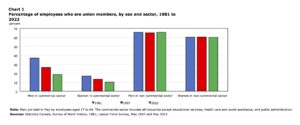
Canada’s unionization rate is dropping
By Adam Freill
LabourOver the past 40 years, the country’s percentage of workers in unionized environments has fallen to 29 per cent.

(Sources: Statistics Canada, Survey of Work History, 1981; Labour Force Survey, May 1997 and May 2022.)
As the characteristics of Canada’s major employers have changed, so too has the country’s percentage of workers in unionized environments. A recent report by René Morissette at Statistics Canada indicates the percentage of employees who are union members fell from 38 per cent in 1981 to 29 per cent in 2022. The drop of nine percentage points may be the result of changes in the Canadian labour market, which has seen employment move from manufacturing and towards more service sector jobs over the past four decades.
Not all groups of workers experienced a decline in unionization, however. Union representation fell by 16 percentage points among men but remained stable among women. As a result, 31 per cent of women were unionized in 2022, compared with 26 per cent of men. The report author explains that the decline in unionization observed among men was partly driven by employment shifts away from manufacturing, a sector with traditionally high unionization rates.
Type of job also impacted the likelihood of being a member of a union, with unionization rates falling by almost 11 percentage points in full-time jobs since 1981 but rising by about three percentage points in part-time jobs in that same timeframe.




